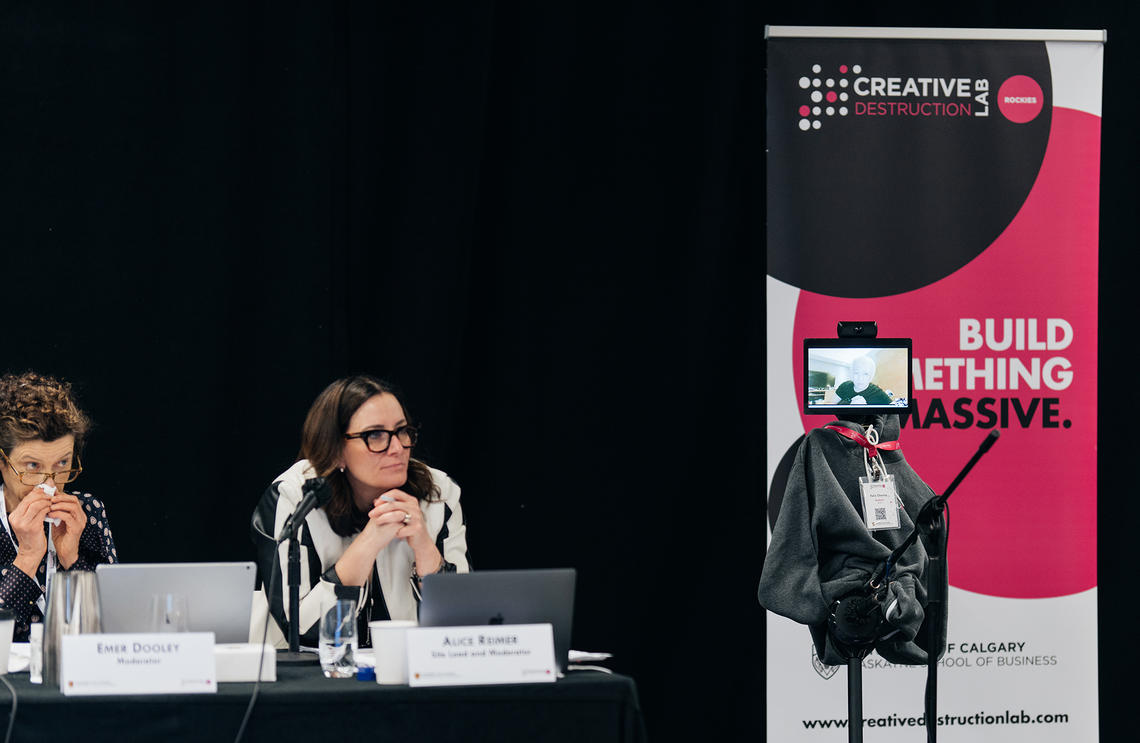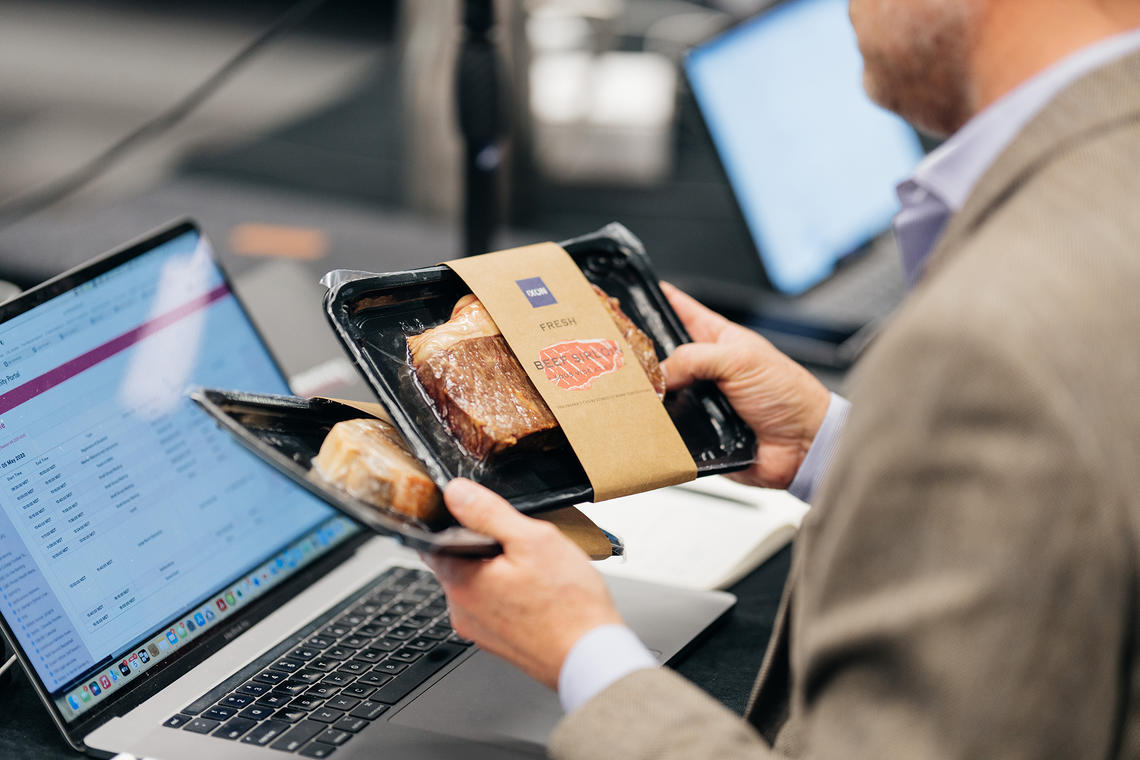Sept. 15, 2022
Creative Destruction Lab - Rockies enters its 6th program year continuing to drive innovation and economic growth in Alberta and beyond

Delivering economic impact in Alberta since 2017, the Creative Destruction Lab - Rockies (CDL-Rockies) program had 19 ventures graduate from the 2021-2022 cohort including a company with a new way to produce hydrogen, a venture that is revolutionizing food packaging, and a company that is helping to address critical ventilator shortages.
“These 19 ventures join the 69 companies that have successfully graduated from CDL-Rockies in the past five years,” says Heather Marshall, site lead, CDL-Rockies. “These graduates have achieved aggressive milestones, set by world-class mentors in the program — and will continue to advance their technologies, grow their employee base and help solve massive challenges through business.”
Marshall takes over as CDL-Rockies’ site lead from Alice Reimer, who continues to scale her own technology company, Fillip Fleet.
“There is no doubt that these companies will continue to add to the equity value created by CDL-Rockies alumni companies, which is now in excess of $2 billion,” says Marshall. “There is high demand for the CDL program with over 250 applications received for a maximum of 75 spots for the next program cycle starting in November.”
In January 2022, CDL-Rockies announced that the site’s participants passed the $1 billion threshold and now that figure is surpassing $2 billion.
Ag stream graduate – IXON
“For the first time in history, we have a way to green label red meats,” says Felix Cheung, founder and CEO, IXON Food Technology. “Canned food was invented 210 years ago, and there has been little or no progress in this arena until now. We have a technology that has the convenience and shelf life of canned food, but at the same time, the taste and nutrition value of premium food.”

Felix Cheung attends CDL session remotely
Kelly Hofer for the Haskayne School of Business
IXON is a team of food scientists, engineers and packaging experts from Hong Kong who have developed a revolutionary food packaging technology — advanced sous-vide aseptic packaging (ASAP) which sterilizes and preserves food using low temperatures. Cheung says their technology will be able to cut out cold-chain storage and transportation for meats, which will eliminate greenhouse gas emissions and help avoid food wastage.

Advanced sous-vide aseptic packaging by IXON Food Technology
Kelly Hofer for the Haskayne School of Business
“We've been on a on a huge world-discovery trip. We visited Alberta and realized the world of people, expertise, technologies and platforms that are available for us to go to the next milestone to prove our technology to get food safety approval,” says Cheung.
“Our next plan is to actually come to Alberta. Our goal is to help Alberta pack all of its red meats to ship all around the world.”
A big draw for IXON to come to Alberta was the ability to tap into the resources at Agri-Food Discovery Place, a University of Alberta-owned pilot plant facility that has the capability to produce samples on an industrial scale and to perform Class II pathogen tests.
Energy stream graduate – Aurora Hydrogen
Aurora Hydrogen raised US$10 million in Series A funding which they announced on Aug. 1, 2022. The company plans to use these funds to build a demonstration plant in Fort Saskatchewan, Alta. — an ecosystem hot spot for hydrogen.
Almost half of the world’s hydrogen use is for oil upgrading — taking heavy oil and adding hydrogen to make diesel or other products. The other half is used to make ammonia for fertilizer. Production in both these areas occurs in Fort Saskatchewan, which is the largest point of hydrogen production and consumption in Canada.

The team from Aurora Hydrogen, from left: Dr. Murray Thomson, chief science officer; Erin Bobicki; and Andrew Gillis.
Adrian Shellard, for the Haskayne School of Business
Aurora’s technology uses microwave energy to heat natural gas in the absence of oxygen and water (pyrolysis) to produce hydrogen and solid carbon while avoiding the generation of CO2.
“In addition to having no CO2 emissions from the process, the technology lends itself to operating in a distributed fashion — making hydrogen where it's required and not having to transport hydrogen, thus avoiding the need for pipeline infrastructure,” says Andrew Gillis, chief executive officer, Aurora Hydrogen.
Beyond the test site, there are more Alberta connections for this deep-science venture. Chief Technology Officer Dr. Erin Bobicki is an associate professor at the University of Alberta who was brought into the venture because of her unique experience in applying microwave energy to industrial processes.
“What we're proposing here is a way to take natural gas, which is currently a massive resource in Canada but also has a lot of carbon emissions associated with it, and produce a high-value clean energy source,” says Gillis.
“We really think it's a win-win where we're able to use an existing resource, where we have all the infrastructure and a lot of Albertan and Canadian expertise associated with it and make a clean, no carbon-emitting fuel.”
Prime stream graduate – Convergence Medical Sciences
“There are a lot of parallels between the challenges of business and the challenges of a researcher,” says Dr. Steven Roy, MD, president and chief medical officer, Convergence Medical Sciences Ltd. “There is a funding challenge. There is an authorization challenge — in one case it is institutional review boards and in the other case it is governmental authorization.”

Steven Roy
Adrian Shellard for the Haskayne School of Business
Roy found the Creative Destruction Lab program to be the perfect fit to accelerate his product, the Valence InVent Xtend — an adjustable valve enclosure and ventilator multiplexor, to market.
Developed as a response to ventilator shortages during the COVID-19 pandemic, the Valence InVent Xtend can be used in any situation to expand the capabilities of limited ventilator infrastructure. The product has multiple patents, an interim order authorization from Health Canada and an FDA application pending.
In addition to helping guide the path to commercialization, the CDL program helped to make valuable connections for Roy. One of the mentors in the program connected Roy to a business contact in Asia which may result in the Valence InVent Xtend being distributed in that part of the world.
“There are certainly big things that happened to our business in the last part of CDL that were attributable to the program,” says Roy.
2021-2022 CDL-Rockies graduating ventures
“The objectives-based program CDL has developed helps ventures with novel technologies realize their full commercial potential. We have had scientists who have come in the program with a great innovation and come out with major progress on that innovation, a critical understanding of their market and business development needs, and connections to an extraordinary network of investors, technical experts and founders,” says Marshall.
“With the depth of innovation in Alberta universities and the larger innovation ecosystem, there are many more ventures to be developed or that can be supported by the unique infrastructure we have here.”
The ventures highlighted above are just an example of the revolutionary graduates from each of the streams within CDL-Rockies. Watch the 2021-2022 CDL-Rockies graduating ventures as they continue to grow:
Ag stream
Energy stream
Prime stream






